Catalytic Ozonation of Sulfachloropyridazine Sodium by Diatomite-Modified Fe2O3: Mechanism and Pathway
Abstract
1. Introduction
2. Results and Discussion
2.1. Factors on the Catalytic Ozone Efficiency of Fe2O3/Dia
2.1.1. Catalyst Dosage
2.1.2. Ozone Dosage
2.1.3. pH
2.1.4. Temperature
2.2. Ozone Oxidation of SPDZ Catalyzed by Catalyst before and after Modification
2.3. Identification of Major ROSs
2.4. Reaction Mechanism
2.5. Mechanism and Pathway of SPDZ Degradation
2.6. Reuse of Fe2O3/Dia
3. Materials and Methods
3.1. Materials
3.2. Catalysts Preparation
3.3. Catalytic Ozone Oxidation
3.4. Analysis Methods
4. Conclusions
Author Contributions
Funding
Data Availability Statement
Conflicts of Interest
References
- Loughlin, T.M.M.; Mac, L.H.; Bahl, M.F.; Flores, F.M.; Apartin, C.D.; Marino, D.J.G.; Peluso, M.L. Assessment of sulfonamide contamination in aquatic environments: A first report for Argentina and environmental risk assessment. Sci. Total Environ. 2024, 934, 173139. [Google Scholar] [CrossRef] [PubMed]
- Chen, J.; Xie, S. Overview of sulfonamide biodegradation and the relevant pathways and microorganisms. Sci. Total Environ. 2018, 640–641, 1465–1477. [Google Scholar] [CrossRef]
- Li, L.; Chai, W.; Sun, C.; Huang, L.; Sheng, T.; Song, Z.; Ma, F. Role of microalgae-bacterial consortium in wastewater treatment: A review. J. Environ. Manag. 2024, 360, 121226. [Google Scholar] [CrossRef] [PubMed]
- Yu, T.; Wang, L.; Ma, F.; Yang, J.; Bai, S.; You, J. Self-immobilized biomixture with pellets of Aspergillus niger Y3 and Arthrobacter. sp ZXY-2 to remove atrazine in water: A bio-functions integration system. Sci. Total Environ. 2019, 689, 875–882. [Google Scholar] [CrossRef] [PubMed]
- Binupriya, A.R.; Sathishkumar, M.; Swaminathan, K.; Kuz, C.S.; Yun, S.E. Comparative studies on removal of Congo red by native and modified mycelial pellets of Trametes versicolor in various reactor modes. Bioresour. Technol. 2008, 99, 1080–1088. [Google Scholar] [CrossRef] [PubMed]
- Zhang, X.; Wang, L.; Ma, F.; Shan, D. Effects of arbuscular mycorrhizal fungi on N2O Emissions from rice paddies. Water Air Soil Pollut. 2015, 226, 222. [Google Scholar] [CrossRef]
- Li, L.; Xu, H.; Zhang, Q.; Zhan, Z.; Liang, X.; Xing, J. Estimation methods of wetland carbon sink and factors influencing wetland carbon cycle: A review. Carbon Res. 2024, 3, 50. [Google Scholar] [CrossRef]
- Deng, Y.; Wu, Y.; Liu, G. Species evenness affects algae driven co-metabolism with aquatic plant residues. Carbon Res. 2022, 1, 26. [Google Scholar] [CrossRef]
- Li, L.; Han, J.; Huang, L.; Liu, L.; Qiu, S.; Ding, J.; Liu, X.; Zhang, J. Activation of PMS by MIL-53;(Fe)@AC composites contributes to tetracycline degradation: Properties and mechanisms. Surf. Interfaces 2024, 51, 104521. [Google Scholar] [CrossRef]
- Todkar, S.S.; Patil, S.A. Review on mechanical properties evaluation of pineapple leaf fibre (PALF) reinforced polymer composites. Compos. Part B-Eng. 2019, 174, 106927. [Google Scholar] [CrossRef]
- Liu, B.; Huang, B.; Ma, X.; Huang, H.; Zou, C.; Liu, J.; Luo, Q.; Wang, C.; Liang, J. Recent advances in peracetic acid-based advanced oxidation processes for emerging pollutants elimination: A review. J. Environ. Chem. Eng. 2024, 12, 112927. [Google Scholar] [CrossRef]
- Zhao, X.; Guo, M.; Wang, Y.; Jin, M.; Hou, N.; Wu, H. Toxic effects of nanoplastics on biological nitrogen removal in constructed wetlands: Evidence from iron utilization and metabolism. Water Res. 2024, 256, 121577. [Google Scholar] [CrossRef] [PubMed]
- Zhang, T.; Shi, Y.; Liu, Y.; Yang, J.; Guo, M.; Bai, S.; Hou, N.; Zhao, X. A study on microbial mechanism in response to different nanoplastics concentrations in constructed wetland and its carbon footprints analysis. Chem. Eng. J. 2024, 480, 148023. [Google Scholar] [CrossRef]
- Wang, D.; Xu, H.; Ma, J.; Giannakis, S.; Lu, X.; Chi, H.; Song, S.; Qi, J. Enhanced mineralization of atrazine by surface induced hydroxyl radicals over light-weight granular mixed-quartz sands with ozone. Water. Res. 2019, 149, 136–148. [Google Scholar] [CrossRef] [PubMed]
- Li, C.; Zhang, P.; Gu, F.; Tong, L.; Jiang, J.; Zuo, Y.; Dong, H. Atomically dispersed Au confined by oxygen vacancies in Au-θ-Al2O3/Au/PCN hybrid for boosting photocatalytic CO2 reduction driven by multiple built-in electric fields. Chem. Eng. J. 2023, 476, 146514. [Google Scholar] [CrossRef]
- Ma, J.; Graham, N.J.D. Degradation of atrazine by manganese-catalysed ozonation—Influence of radical scavengers. Water Res. 2000, 34, 3822–3828. [Google Scholar] [CrossRef]
- Jiang, J.; Li, N.; Zou, J.; Zhou, X.; Eda, G.; Zhang, Q.; Zhang, H.; Li, L.; Zhai, T.; Wee, A.T.S. Synergistic additive-mediated CVD growth and chemical modification of 2D materials. Chem. Soc. Rev. 2019, 48, 4639–4654. [Google Scholar] [CrossRef] [PubMed]
- Ma, J.; Li, X.; Zhang, C.; Ma, Q.; He, H. Novel CeMnaOx catalyst for highly efficient catalytic decomposition of ozone. Appl. Catal. B Environ. 2020, 264, 118498. [Google Scholar] [CrossRef]
- Song, X.; Wang, P.; Zwieten, L.V.; Bolan, N.; Wang, H.; Li, X. Towards a better understanding of the role of Fe cycling in soil for carbon stabilization and degradation. Carbon Res. 2022, 1, 5. [Google Scholar] [CrossRef]
- Li, L.; Fu, R.; Zou, J.; Wang, S.; Ding, J.; Han, J.; Zhao, M. Research Progress of Iron-Based Catalysts in Ozonation Wastewater Treatment. ACS ES&T Water. 2023, 3, 908. [Google Scholar]
- Shaheen, S.M.; Mosa, A.; Natasha, H.; Abdelrahman, N.K.; Niazi, V.; Antoniadis, M.; Shahid, H.; Kwon, E.E.; Rinklebe, J. Removal of toxic elements from aqueous environments using nano zero-valent iron- and iron oxide-modified biochar: A review. Biochar 2022, 4, 24. [Google Scholar] [CrossRef]
- Yan, L.; Bing, J.; Wu, H. The behavior of ozone on different iron oxides surface sites in water. Sci. Rep. 2019, 9, 14752. [Google Scholar] [CrossRef] [PubMed]
- Zhu, S.; Dong, B.; Yu, Y.; Bu, L.; Deng, J.; Zhou, S. Heterogeneous catalysis of ozone using ordered mesoporous Fe3O4 for degradation of atrazine. Chem. Eng. 2017, 328, 527–535. [Google Scholar] [CrossRef]
- Chen, C.; Yan, X.; Yoza, B.; Zhou, T.; Li, Y.; Zhan, Y.; Wang, Q.; Li, Q. Efficiencies and mechanisms of ZSM5 zeolites loaded with cerium, iron, or manganese oxides for catalytic ozonation of nitrobenzene in water. Sci. Total Environ. 2018, 612, 1424–1432. [Google Scholar] [CrossRef]
- Zhao, L.; Ma, J.; Sun, Z.; Liu, H. Influencing mechanism of temperature on the degradation of nitrobenzene in aqueous solution by ceramic honeycomb catalytic ozonation. J. Hazard. Mater. 2009, 167, 1119–1125. [Google Scholar] [CrossRef] [PubMed]
- Li, L.; Lv, Y.; Jia, C.; Yin, D.; Dong, Z.; Zhan, Z.; Han, J.; Zhang, J. Preparation of sludge–cyanobacteria composite carbon for synergistically enhanced co-removal of Cu(II) and Cr(VI). Chemosphere 2023, 320, 138043. [Google Scholar] [CrossRef] [PubMed]
- Zhao, C.; Liu, J.; Li, B.; Ren, D.; Chen, X.; Yu, J.; Zhang, Q. Multiscale Construction of Bifunctional Electrocatalysts for Long-Lifespan Rechargeable Zinc–Air Batteries. Adv. Funct. Mater. 2020, 30, 2003619. [Google Scholar] [CrossRef]
- Wang, H.; Liang, H.; Chang, M. Chlorobenzene oxidation using ozone over iron oxide and manganese oxide catalysts. J. Hazard. Mater. 2011, 186, 1781–1787. [Google Scholar] [CrossRef]
- Liu, J.; Peng, C.; Shi, X. Preparation, characterization, and applications of Fe-based catalysts in advanced oxidation processes for organics removal: A review. Environ. Pollut. 2022, 293, 118565. [Google Scholar] [CrossRef]
- Botas, J.A.; Melero, J.A.; Martínez, F.; Pariente, M.I. Assessment of Fe2O3/SiO2 catalysts for the continuous treatment of phenol aqueous solutions in a fixed bed reactor. Catalysis Today 2010, 149, 334–340. [Google Scholar] [CrossRef]
- Wang, C.; Zhou, G.; Xu, Y.; Yu, P. The Effect of Magnetic Composites (γ-Al2O3/TiO2/γ-Fe2O3) as Ozone Catalysts in Wastewater Treatment. Materials 2022, 15, 8459. [Google Scholar] [CrossRef]
- Zhang, X.; Yang, H.; Li, S.; Qin, G.; Yang, L. Natural diatomite particles: Size-, dose- and shape- dependent cytotoxicity and reinforcing effect on injectable bone cement. Mater. Sci. Technol. 2018, 34, 1044–1053. [Google Scholar] [CrossRef]
- Li, S.; Li, D.; Su, F.; Ren, Y.; Qin, G. Uniform surface modification of diatomaceous earth with amorphous manganese oxide and its adsorption characteristics for lead ions. Appl. Surf. Sci. 2014, 317, 724–729. [Google Scholar] [CrossRef]
- Li, B.; Xu, X.; Zhu, L.; Ding, W.; Mahmood, Q. Catalytic ozonation of industrial wastewater containing chloro and nitro aromatics using modified diatomaceous porous filling. Desalination 2010, 254, 90–98. [Google Scholar] [CrossRef]
- Yuan, P.; Wu, D.Q.; He, H.; Lin, Z. The hydroxyl species and acid sites on diatomite surface: A combined IR and Raman study. Appl. Surf. Sci. 2004, 227, 30–39. [Google Scholar] [CrossRef]
- Dong, Q.; Fang, Y.; Tan, B. Antimonate removal by diatomite modified with Fe-Mn oxides: Application and mechanism study. Environ. Sci. Pollut. Res. 2021, 28, 13873–13885. [Google Scholar] [CrossRef]
- Wang, Q.; Shao, Y.; Gao, N.; Chu, W.; Chen, J.; Lu, X.; Zhu, Y.; An, N. Activation of peroxymonosulfate by Al2O3-based CoFe2O4 for the degradation of sulfachloropyridazine sodium: Kinetics and mechanism. Sep. Purif. Technol. 2017, 189, 176–185. [Google Scholar] [CrossRef]
- Zhang, X.; Wang, L.; Ma, F. Effects of arbuscular mycorrhizal fungi inoculation on carbon and nitrogen distribution and grain yield and nutritional quality in rice (Oryza sativa L.). J. Sci. Food Agric. 2017, 97, 2919–2925. [Google Scholar] [CrossRef] [PubMed]
- Jiang, J.; Li, F.; Ding, L.; Zhang, C.; Arramel, X. MXenes/CNTs-based hybrids: Fabrications, mechanisms, and modification strategies for energy and environmental applications. Nano Res. 2024, 17, 3429–3454. [Google Scholar] [CrossRef]
- Liang, D.; Hu, Y.; Xiao, C.; Wang, G.; Xie, J.; Zhu, X. Highly efficient catalytic ozonation for ammonium in water upon γ-Al2O3@Fe/Mg with acidic-basic sites and oxygen vacancies. Sci. Total Environ. 2022, 834, 155278. [Google Scholar] [CrossRef]
- Wang, X.; Liang, D.; Wang, Y.; Peijnenburg, W.J.G.M.; Monikh, F.A.; Zhao, X.; Dong, Z.; Fan, W. A critical review on the biological impact of natural organic matter on nanomaterials in the aquatic environment. Carbon Res. 2022, 1, 13. [Google Scholar] [CrossRef]
- Lu, Y.; Wang, Q.; Yu, F.; Zhang, S.; Zhu, X. Carbothermal reduction synthesis of sulfide-modified biochar for heavy metal removal. Carbon Res. 2023, 2, 5. [Google Scholar] [CrossRef]
- Liu, Y.; He, H.; Wu, D. Heterogeneous Catalytic Ozonation Reaction Mechanism. Prog. Chem. 2016, 28, 1112–1120. [Google Scholar]
- Ma, J.; Zhang, S.; Duan, X.; Wang, Y.; Wu, D.; Pang, J.; Wang, X.; Wang, S. Catalytic oxidation of sulfachloropyridazine by MnO2: Effects of crystalline phase and peroxide oxidants. Chemosphere 2021, 267, 129287. [Google Scholar] [CrossRef] [PubMed]
- Haidar, M.; Dirany, A.; Sires, I.; Oturan, N.; Oturan, M.A. Electrochemical degradation of the antibiotic sulfachloropyridazine by hydroxyl radicals generated at a BDD anode. Chemosphere 2013, 91, 1304–1309. [Google Scholar] [CrossRef] [PubMed]
- Li, L.; He, Z.; Liang, T.; Sheng, T.; Zhang, F.; Wu, D.; Ma, F. Colonization of biofilm in wastewater treatment: A review. Environ. Pollut. 2022, 293, 118514. [Google Scholar] [CrossRef] [PubMed]
- Li, L.; Liang, T.; Zhao, M.; Lv, Y.; Song, Z.; Sheng, T.; Ma, F. A review on mycelial pellets as biological carriers: Wastewater treatment and recovery for resource and energy. Bioresour. Technol. 2022, 355, 127200. [Google Scholar] [CrossRef] [PubMed]
- Liu, Z.; Xu, Z.; Xu, L.; Buyong, F.; Chay, T.; Zhuang, L.; Cai, Y.; Hu, B.; Zhu, Y.; Wang, X. Modified biochar: Synthesis and mechanism for removal of environmental heavy metals. Carbon Res. 2022, 1, 8. [Google Scholar] [CrossRef]
- Askarinejad, A.; Bagherzadeh, M.; Morsali, A. Catalytic performance of Mn3O4 and Co3O4 nanocrystals prepared by sonochemical method in epoxidation of styrene and cyclooctene. Exp. Nano Sci. 2011, 6, 217–225. [Google Scholar] [CrossRef]
- Son, B.H.D.; Mai, V.Q.; Du, D.X.; Phong, N.H.; Cuong, N.D.; Khieu, D.Q. Catalytic wet peroxide oxidation of phenol solution over Fe–Mn binary oxides diatomite composite. Porous Mater. 2017, 24, 601–611. [Google Scholar] [CrossRef]
- Nawrocki, J.; Fijolek, L. Catalytic ozonation—Effect of carbon contaminants on the process of ozone decomposition. Appl. Catal. B Environ. 2013, 142, 307–314. [Google Scholar] [CrossRef]
- Qiu, J.; Wang, J.; Ren, M.; Yang, X.; Zhang, J.; Zhang, X.; Cao, H.; Xie, Y. Comprehensive effect of water matrix on catalytic ozonation of chloride contained saline wastewater. Water Res. 2023, 234, 119827. [Google Scholar] [CrossRef]
- Fang, Y.; Zhao, S.; Su, C.; Lü, N.; Wang, H. Variation of pH value of leaching solution during steel slag dissolution. J. Min. Sci. Technol. 2023, 8, 512–518. [Google Scholar]
- Psaltou, S.; Mitrakas, M.; Zouboulis, A. Heterogeneous Catalytic Ozonation: Solution pH and Initial Concentration of Pollutants as Two Important Factors for the Removal of Micropollutants from Water. Separations 2022, 9, 413. [Google Scholar] [CrossRef]
- Xiong, X.; Wang, B.; Zhu, W. A Review on Ultrasonic Catalytic Microbubbles Ozonation Processes: Properties, Hydroxyl Radicals Generation Pathway and Potential in Application. Catalysts 2019, 9, 10. [Google Scholar] [CrossRef]
- Nawrocki, J. Catalytic ozonation in water: Controversies and questions. Discussion Paper. Appl. Catal. B 2013, 142, 465–471. [Google Scholar] [CrossRef]
- Tatibouet, J.M.; Valange, S.; Touati, H. Near-ambient temperature ozone decomposition kinetics on manganese oxide-based catalysts. Appl. Catal. A 2019, 569, 126–133. [Google Scholar] [CrossRef]
- Wang, Y.; Chen, L.; Chen, C.; Xi, J.; Cao, H.; Duan, X.; Xie, Y.; Song, W.; Wang, S. Occurrence of both hydroxyl radical and surface oxidation pathways in N-doped layered nanocarbons for aqueous catalytic ozonation. Appl. Catal. B 2019, 254, 283–291. [Google Scholar] [CrossRef]
- Yan, P.; Shen, J.; Yuan, L.; Kang, J.; Wang, B.; Zhao, S.; Chen, Z. Catalytic ozonation by Si-doped α-Fe2O3 for the removal of nitrobenzene in aqueous solution. Sep. Purif. Technol. 2019, 228, 115766. [Google Scholar] [CrossRef]
- Stranic, I.; Pang, G.A.; Hanson, R.K.; Golden, D.M.; Bowman, C.T. Shock tube measurements of the tert-butanol + OH reaction rate and the tert-C4H8OH radical β-scission branching ratio using isotopic labeling. Phys. Chem. A 2013, 117, 4777–4784. [Google Scholar] [CrossRef]
- Guo, Y.; Long, J.; Huang, J.; Yu, G.; Wang, Y. Can the commonly used quenching method really evaluate the role of reactive oxygen species in pollutant abatement during catalytic ozonation? Water Res. 2022, 215, 118275. [Google Scholar] [CrossRef] [PubMed]
- Pan, J.; Qian, M.; Li, Y.; Wang, H.; Guan, B. Catalytic ozonation of aqueous 4-methylquinoline by fluorinated ceramic honeycomb. Chemosphere 2022, 307, 135678. [Google Scholar] [CrossRef] [PubMed]
- Bandala, E.R.; Sadek, R.; Gurgul, J.; Łątka, K.; Zimowska, M.; Valentin, L.; Rodriguez-Narvaez, O.M.; Dzwigaj, S. Assessment of the capability of Fe and Al modified BEA zeolites to promote advanced oxidation processes in aqueous phase. Chem. Eng. J. 2021, 409, 127379. [Google Scholar] [CrossRef]
- Bao, J.; Yang, J.; Song, X.; Han, R.; Ning, P.; Lu, X.; Fan, M.; Wang, C.; Sun, X.; Li, K. The mineral phase reconstruction of copper slag as Fenton-like catalysts for catalytic oxidation of NOx and SO2: Variation in active site and radical formation pathway. Chem. Eng. J. 2022, 450, 138101. [Google Scholar] [CrossRef]
- Li, L.; Han, J.; Huang, X.; Qiu, S.; Liu, X.; Liu, L.; Zhao, M.; Qu, J.; Zou, J.; Zhang, J. Organic pollutants removal from aqueous solutions using metal-organic frameworks (MOFs) as adsorbents: A review. J. Environ. Chem. Eng. 2023, 11, 111217. [Google Scholar] [CrossRef]
- Wang, Y.; Zhao, X.; Cao, D.; Wang, Y.; Zhu, Y. Peroxymonosulfate enhanced visible light photocatalytic degradation bisphenol A by single-atom dispersed Ag mesoporous g-C3N4 hybrid. Appl. Catal. B. Environ. 2021, 211, 79–88. [Google Scholar] [CrossRef]
- Zhou, X.; Yang, J.; Guo, J.; Xiong, W.; Leung, M.K.H. Advances and Prospects in Electrocatalytic Processes for Wastewater Treatment. Processes 2024, 12, 1615. [Google Scholar] [CrossRef]
- Buxton, G.V.; Greenstock, C.L.; Helman, W.P.; Ross, A.B. Critical Review of rate constants for reactions of hydrated electrons, hydrogen atoms and hydroxyl radicals (OH/O− in Aqueous Solution. Phys. Chem. Ref. 1988, 17, 513–886. [Google Scholar] [CrossRef]
- Qi, C.; Liu, X.; Ma, J.; Lin, C.; Li, X.; Zhang, H. Activation of peroxymonosulfate by base: Implications for the degradation of organic pollutants. Chemosphere 2016, 151, 280–288. [Google Scholar] [CrossRef]
- Costa-Serge, N.D.; Goncalves, R.G.L.; Rojas-Mantilla, H.D.; Santilli, C.V.; Hammer, P.; Nogueira, R.F.P. Fenton-like degradation of sulfathiazole using copper-modified MgFe-CO3 layered double hydroxide. J. Hazard. Mater. 2021, 413, 125388. [Google Scholar] [CrossRef]
- Xu, Z.; Jing, C.; Li, F.; Meng, X. Mechanisms of Photocatalytical Degradation of Monomethylarsonic and Dimethylarsinic Acids Using Nanocrystalline Titanium Dioxide. Environ. Sci. Technol. 2008, 42, 2349–2354. [Google Scholar] [CrossRef] [PubMed]
- Braxton, E.; Fox, D.J.; Breeze, B.G.; Tully, J.J.; Levey, K.J.; Newton, M.E.; Macpherson, J.V. Electron Paramagnetic Resonance for the Detection of Electrochemically Generated Hydroxyl Radicals: Issues Associated with Electrochemical Oxidation of the Spin Trap. ACS Meas. Sci. Au 2023, 3, 21–31. [Google Scholar] [CrossRef] [PubMed]
- Tian, S.; Qi, J.; Wang, Y.; Liu, Y.; Wang, L.; Ma, J. Heterogeneous catalytic ozonation of atrazine with Mn-loaded and Fe-loaded biochar. Water. Res. 2021, 193, 116860. [Google Scholar] [CrossRef] [PubMed]
- Yang, L.; Hu, C.; Nie, Y.; Qu, J. Surface acidity and reactivity of β-FeOOH/Al2O3 for pharmaceuticals degradation with ozone: In situ ATR-FTIR studies. Appl. Catal. B 2010, 97, 340–346. [Google Scholar] [CrossRef]
- Luo, L.; Sun, Z.; Chen, Y.; Zhang, H.; Sun, Y.; Lu, D.; Ma, J. Catalytic ozonation of sulfamethoxazole using low-cost natural silicate ore supported Fe2O3: Influencing factors, reaction mechanisms and degradation pathways. RSC Adv. 2023, 13, 1906–1913. [Google Scholar] [CrossRef] [PubMed]
- Smith, J.; Doe, A. Unveiling the Catalytic Potential of Topological Nodal-Line Semimetal AuSn4 for Hydrogen Evolution and CO2 Reduction. J. Adv. Mater. Res. 2023, 45, 1234–1256. [Google Scholar]
- Du, Y.; Zhen, S.; Wang, J.; Ma, Y.; Wu, J.; Dai, H. FeOOH-MnO2/Sepiolite and Fe2O3-MnO2/Diatomite: Highly efficient adsorbents for the removal of As(V). Appl. Clay Sci. 2022, 222, 106491. [Google Scholar] [CrossRef]
- Chen, W.; Wu, Z.; Peng, R.; Wu, W.; Li, X.; Cao, D.; Zhang, Z.; Niu, K. Low-cost diatomite supported binary transition metal sulfates: An efficient reusable solid catalyst for biodiesel synthesis. RSC Adv. 2023, 13, 6002–6009. [Google Scholar] [CrossRef]
- Srivastava, V.; Kumar, S. Formation of hierarchical structures of Fe2O3 by the liquid–liquid interface technique. Crystengcomm 2014, 16, 11122–11126. [Google Scholar] [CrossRef]
- Zhang, Y.; Li, M.; Zhang, Q. Silicon-modified ferric hydroxide for catalytic ozonation of nitrobenzene in aqueous solution. Desalination Water. Treat. 2015, 54, 2902–2908. [Google Scholar] [CrossRef]
- Tang, X.; Lei, Y.; Yu, C.; Wang, C.; Zhang, P.; Lu, H. Highly-efficient degradation of organic pollutants by oxalic acid modified sludge biochar: Mechanism and pathways. Chemosphere 2023, 325, 138409. [Google Scholar] [CrossRef]
- Conde-Cid, M.; Fernandez-Calvino, D.; Novoa-Munoz, J.C.; Arias-Estevez, M.; Diaz-Ravina, M.; Nunez-Delgado, A.; Fernandez-Sanjurjo, M.J. Degradation of sulfadiazine, sulfachloropyridazine and sulfamethazine in aqueous media. J. Environ. Manag. 2018, 228, 239–248. [Google Scholar] [CrossRef] [PubMed]
- Dirany, A.; Sires, I.; Oturan, N.; Ozcan, A.; Oturan, M.A. Electrochemical treatment of the antibiotic sulfachloropyridazine: Kinetics, reaction pathways, and toxicity evolution. Environ. Sci. Technol. 2012, 46, 4074–4082. [Google Scholar] [CrossRef] [PubMed]
- Ji, Y.; Shi, Y.; Wang, L.; Lu, J.; Ferronato, C.; Chovelon, J.M. Sulfate radical-based oxidation of antibiotics sulfamethazine, sulfapyridine, sulfadiazine, sulfadimethoxine, and sulfachloropyridazine: Formation of SO2 extrusion products and effects of natural organic matter. Sci. Total Environ. 2017, 593, 704–712. [Google Scholar] [CrossRef] [PubMed]
- Liu, L.; Lin, S.; Zhang, W.; Farooq, U.; Shen, G.; Hu, S. Kinetic and mechanistic investigations of the degradation of sulfachloropyridazine in heat-activated persulfate oxidation process. Chem. Eng. 2018, 346, 515–524. [Google Scholar] [CrossRef]
- Ismail, L.; Ferronato, C.; Fine, L.; Jaber, F.; Chovelo, J.M. Elimination of sulfaclozine from water with SO4− radicals: Evaluation of different persulfate activation methods. Appl. Catal. B 2017, 201, 573–581. [Google Scholar] [CrossRef]
- Sun, X.; Feng, M.; Dong, S.; Qi, Y.; Sun, L.; Nesnas, N.V.K. Removal of sulfachloropyridazine by ferrate(VI): Kinetics, reaction pathways, biodegradation, and toxicity evaluation. Chem. Eng. 2019, 372, 742–751. [Google Scholar] [CrossRef]
- Li, J.; Sun, J.; Xu, Z.; Li, X.; Zhao, J.; Liu, J. On stability and synergistic effect of nano-bubbles in micro-silica flotation. J. Min. Sci. Technol. 2022, 7, 763–769. [Google Scholar]
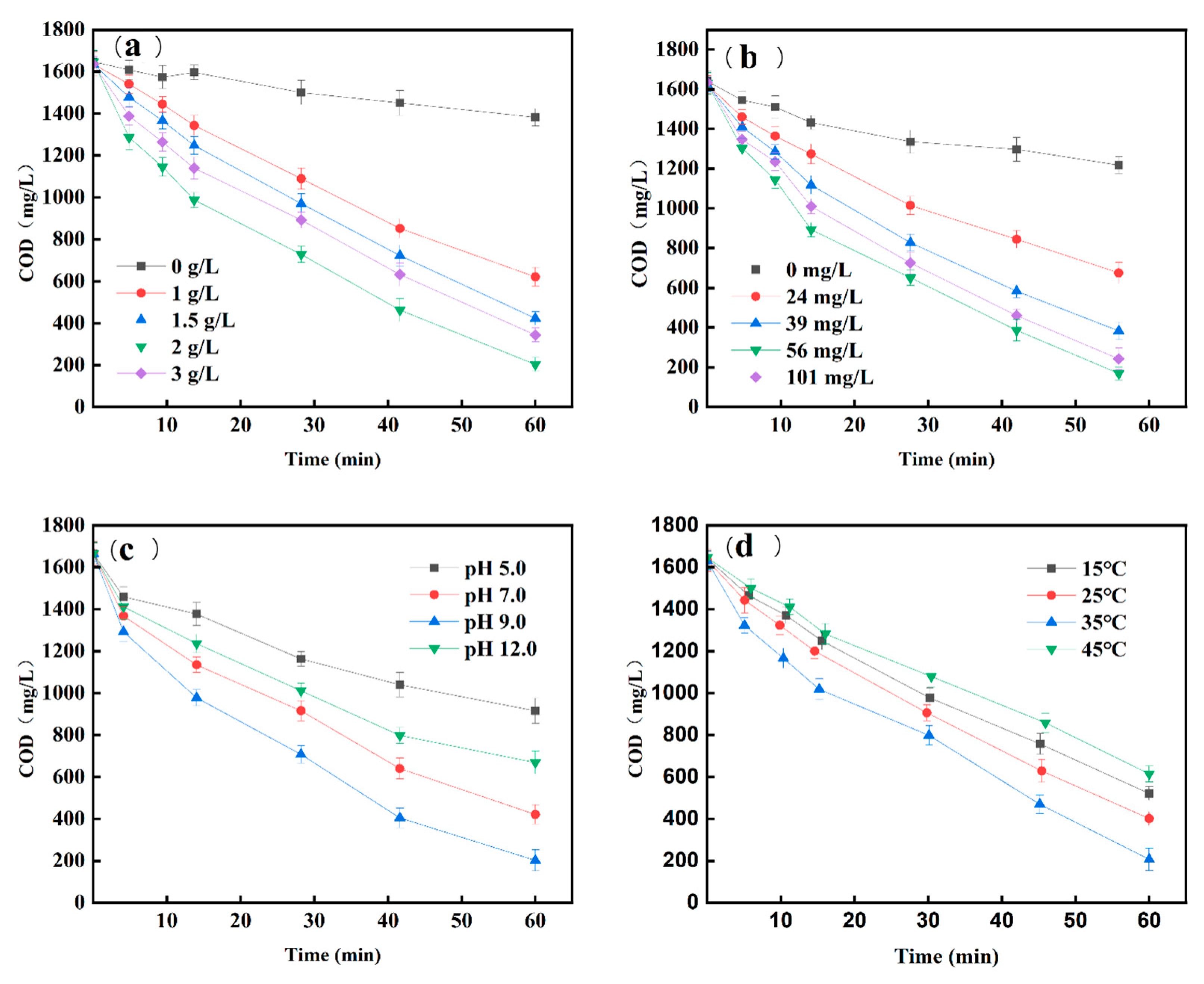
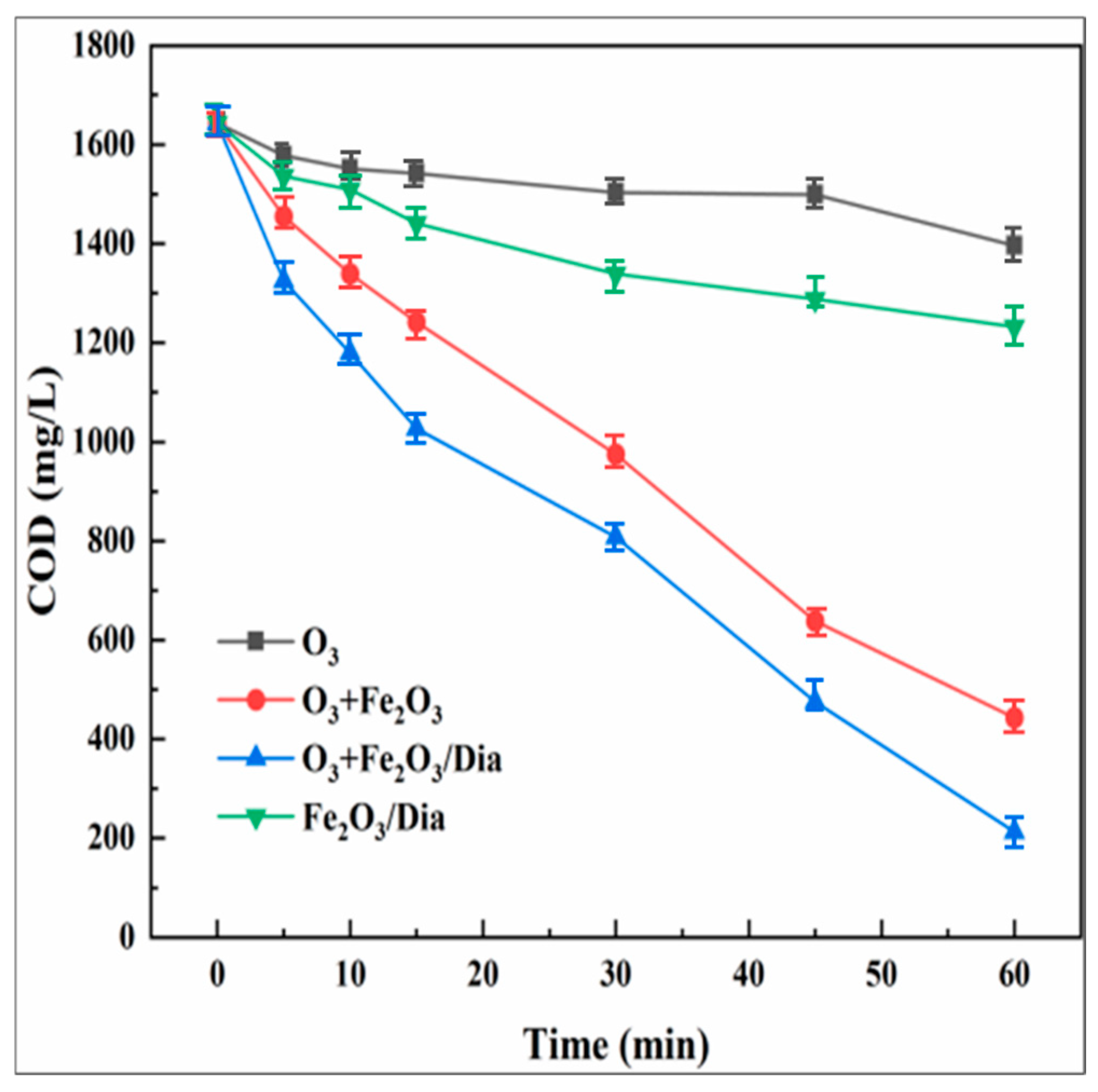
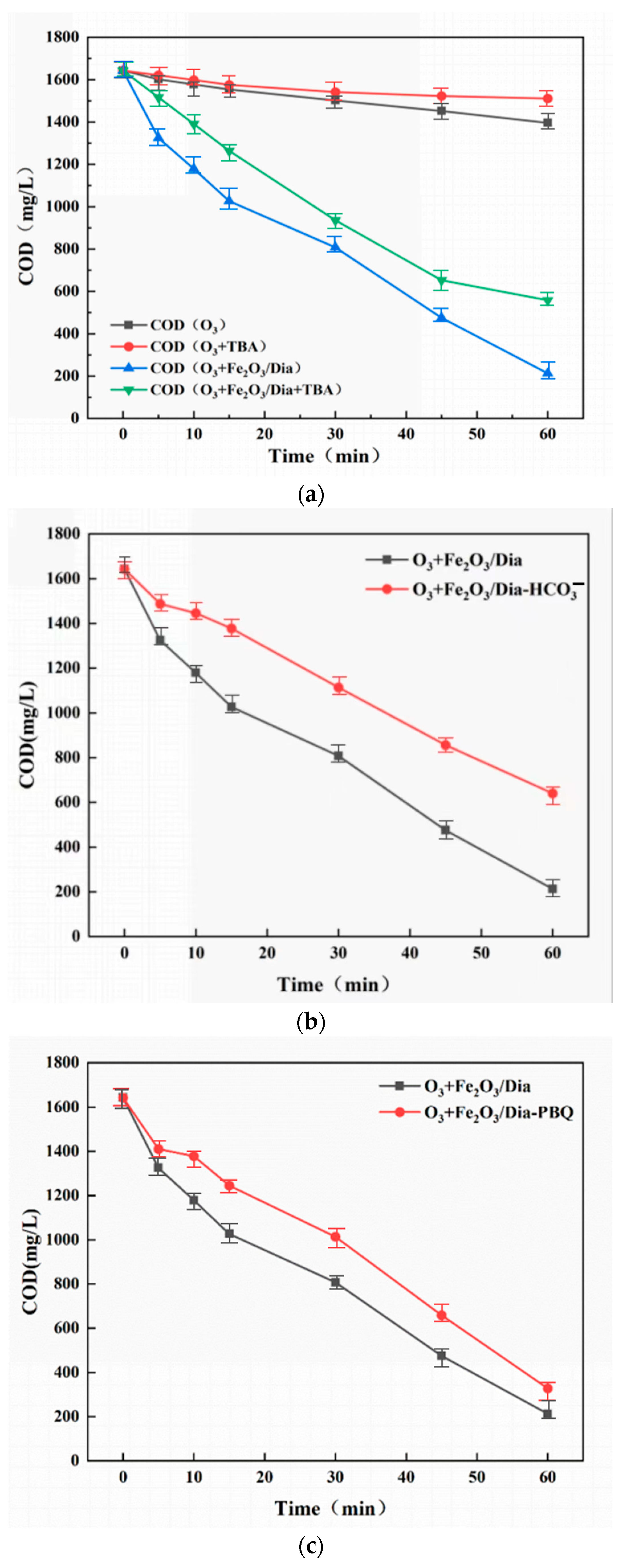
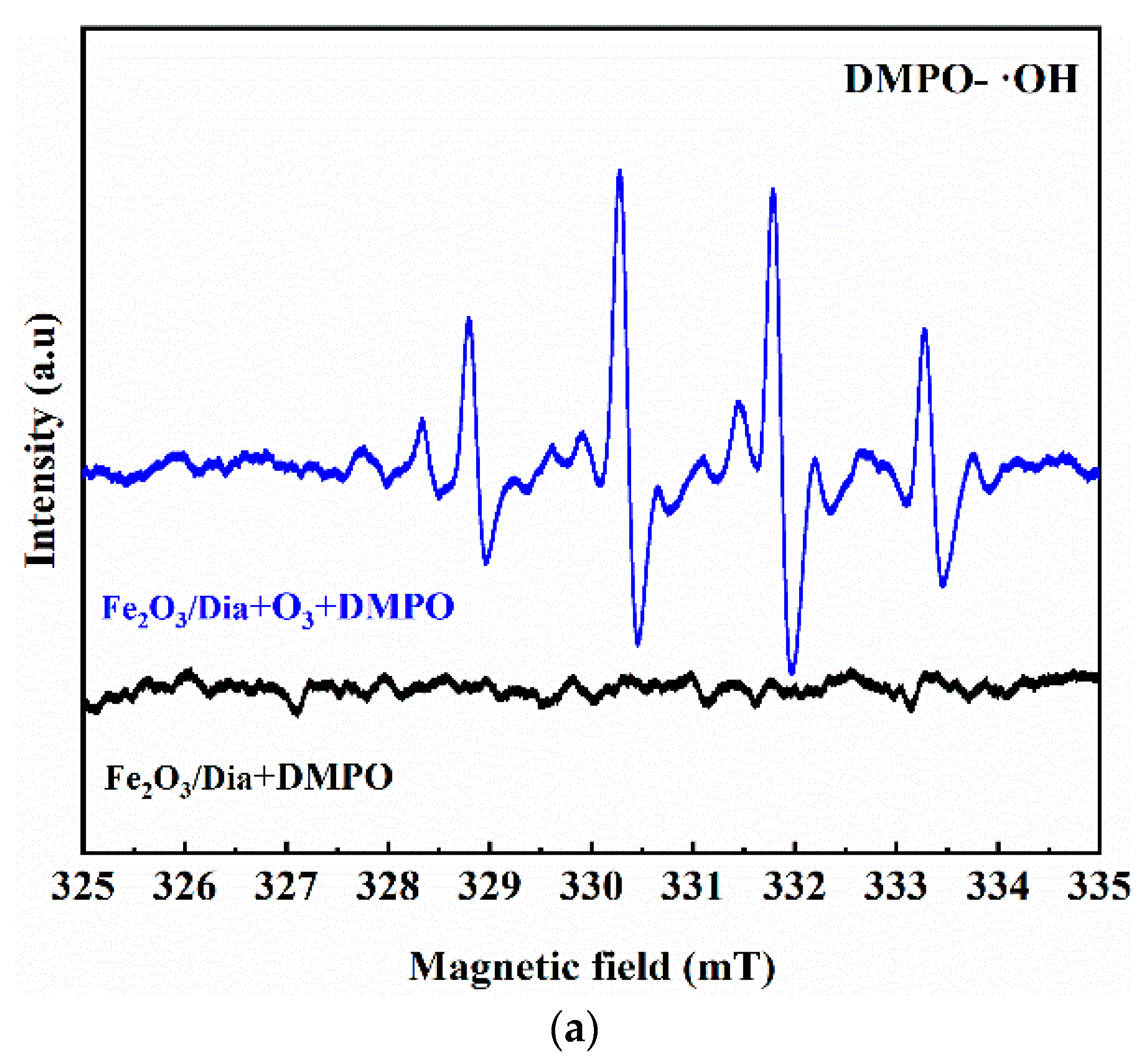


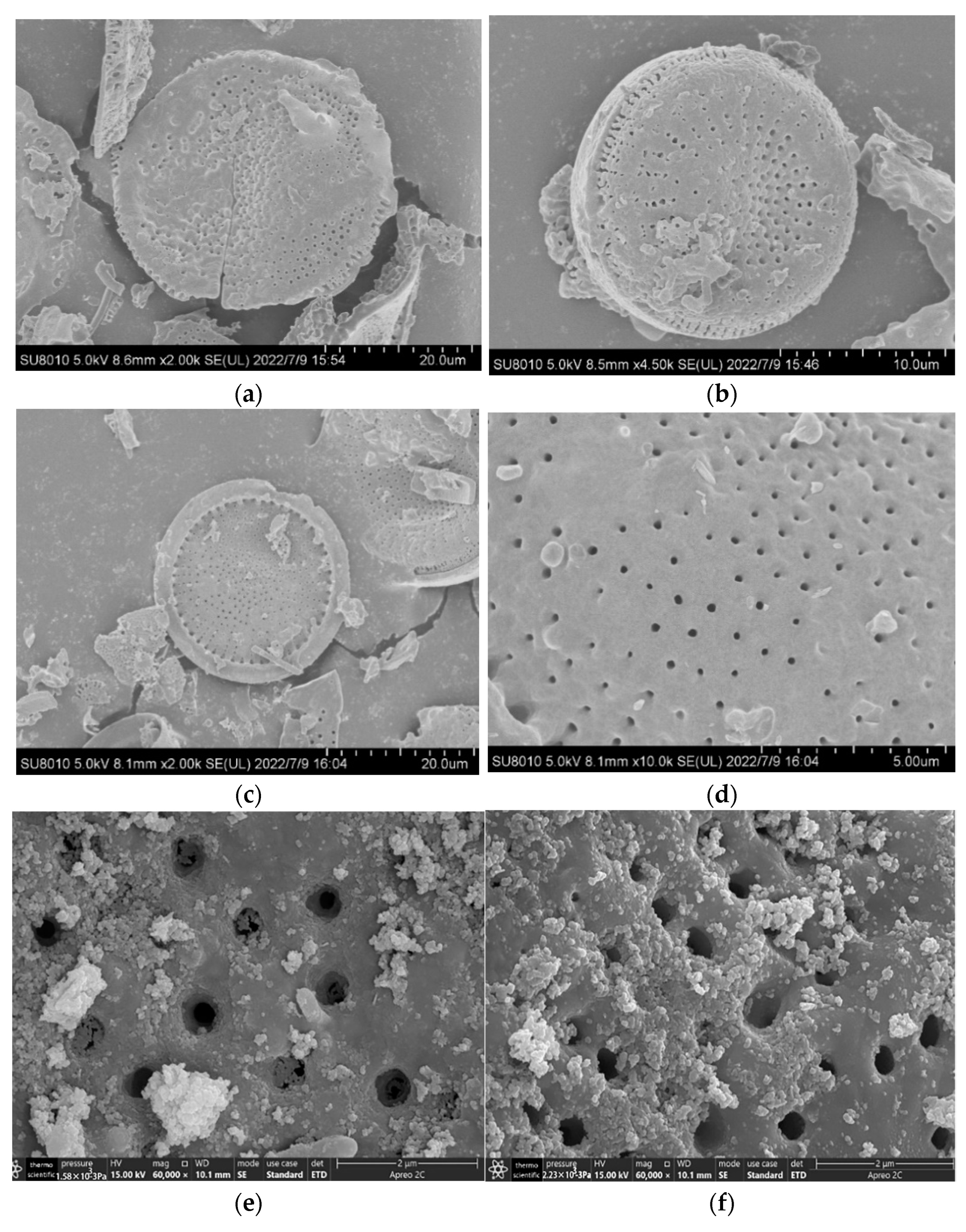
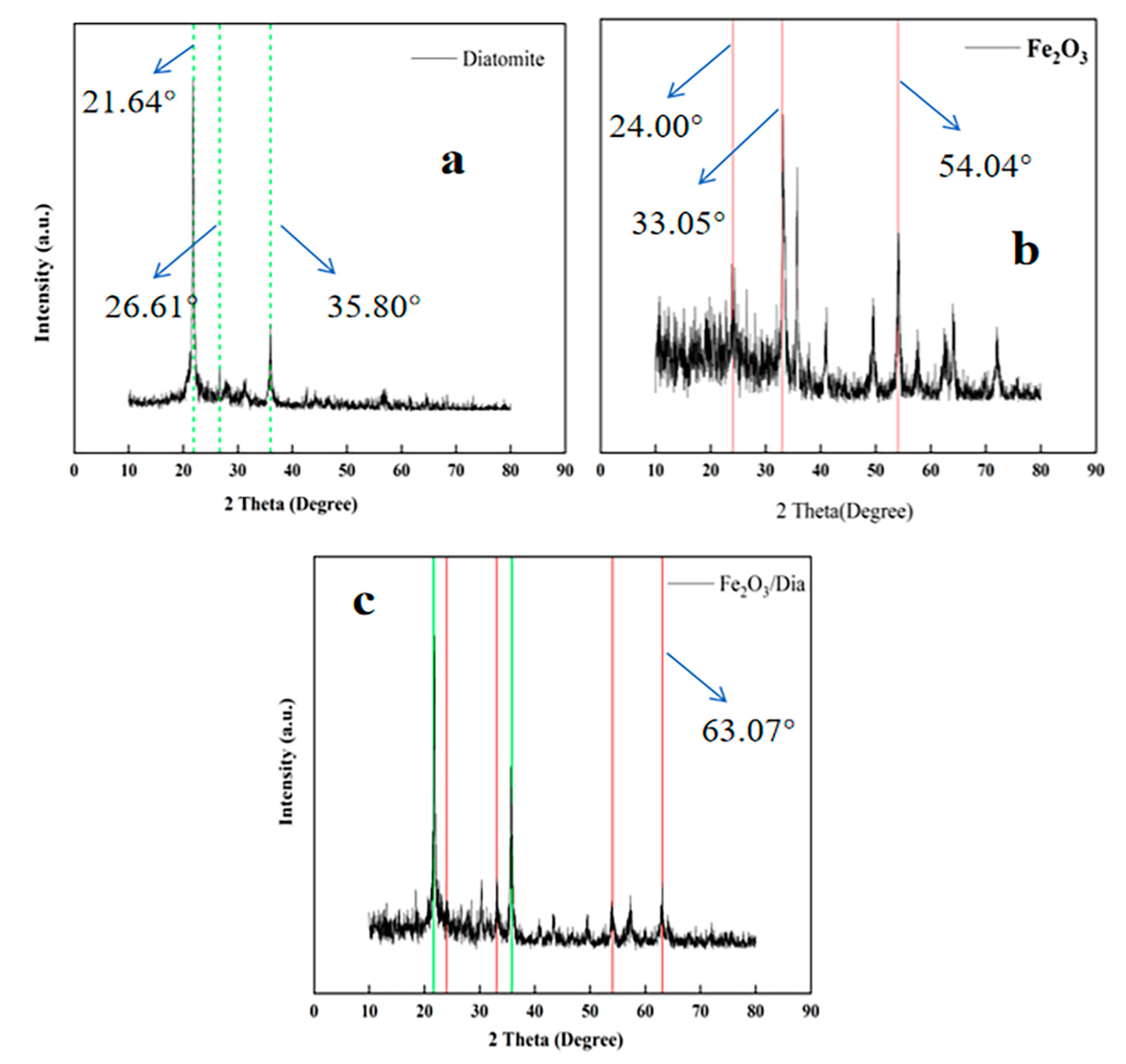
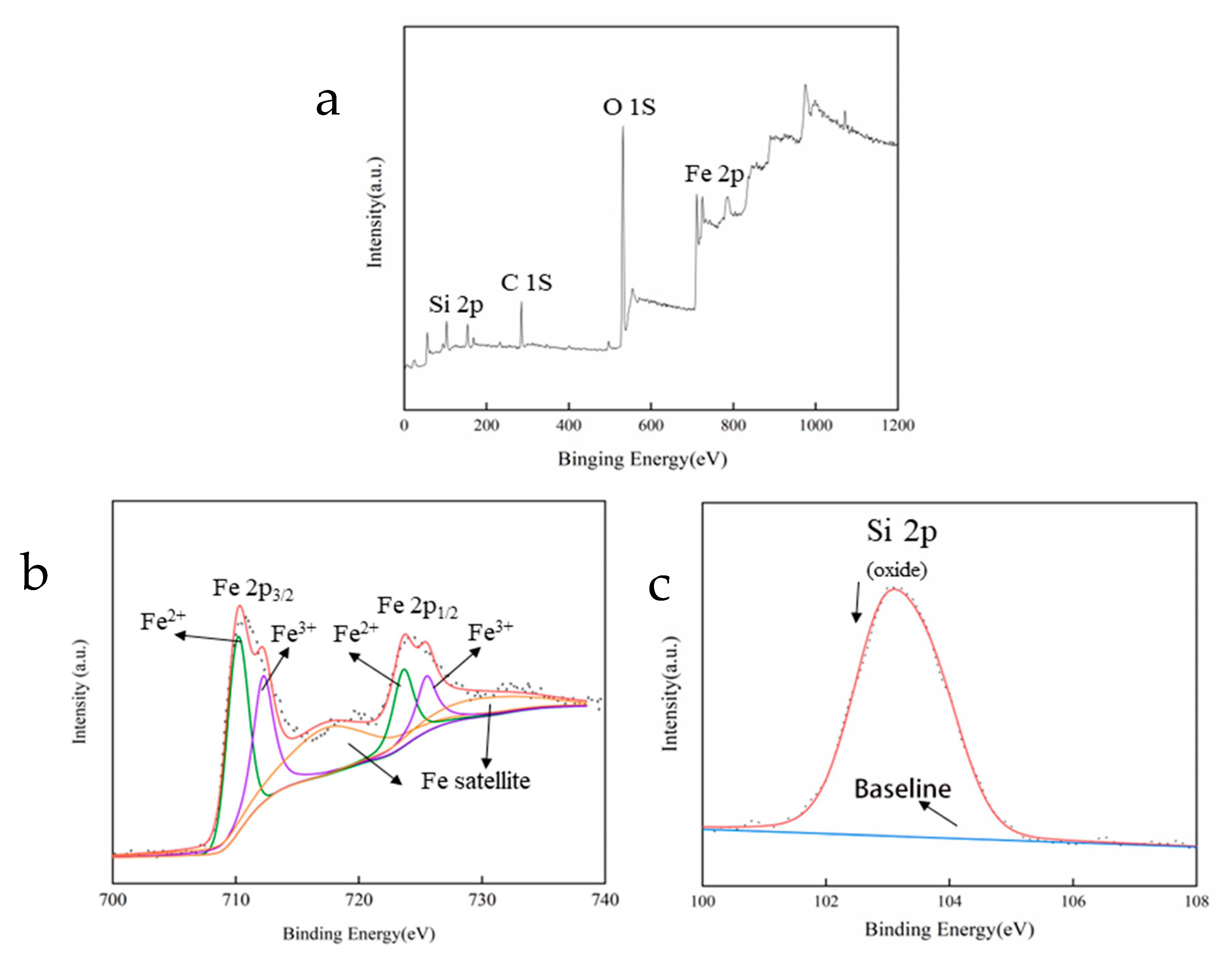

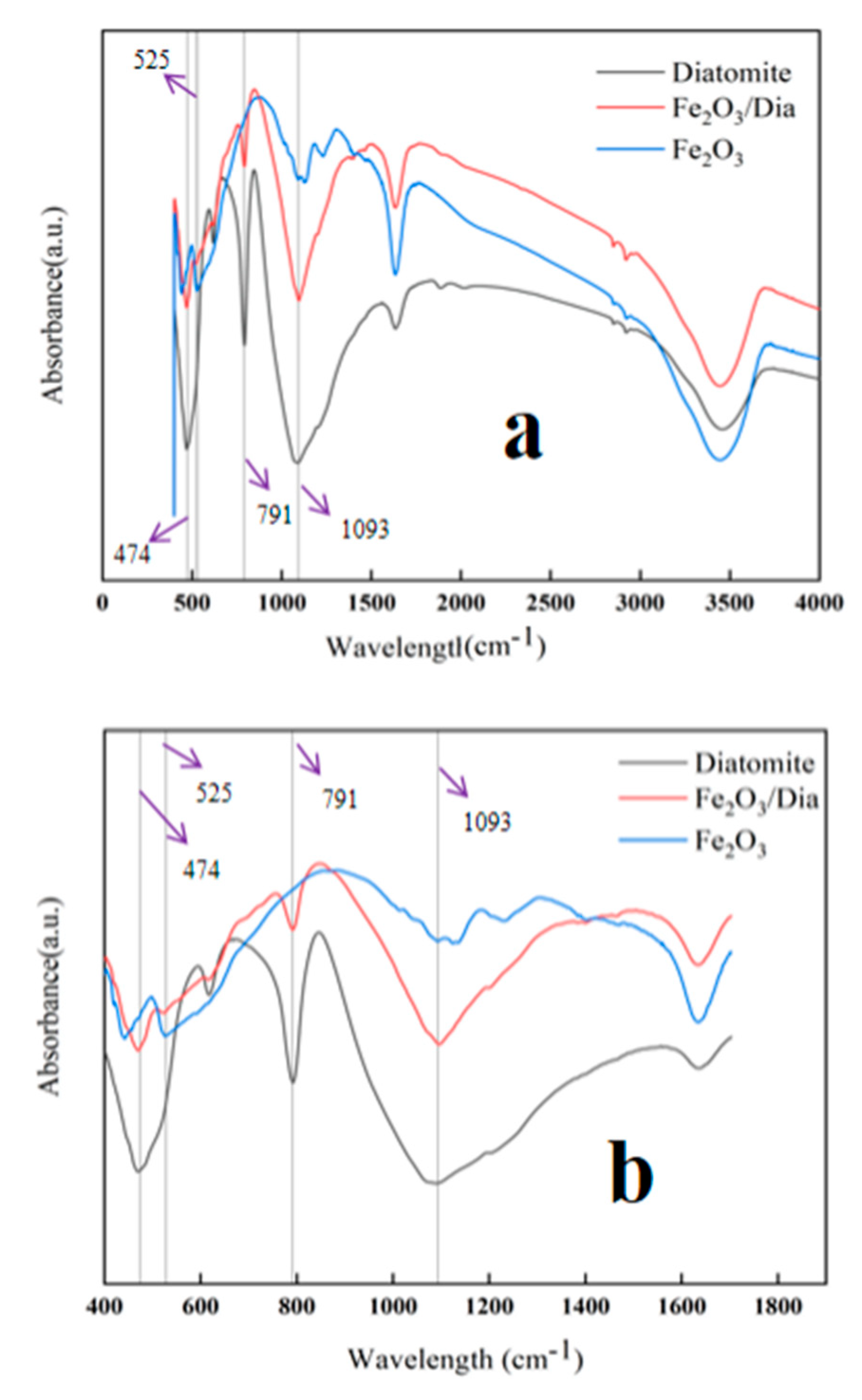
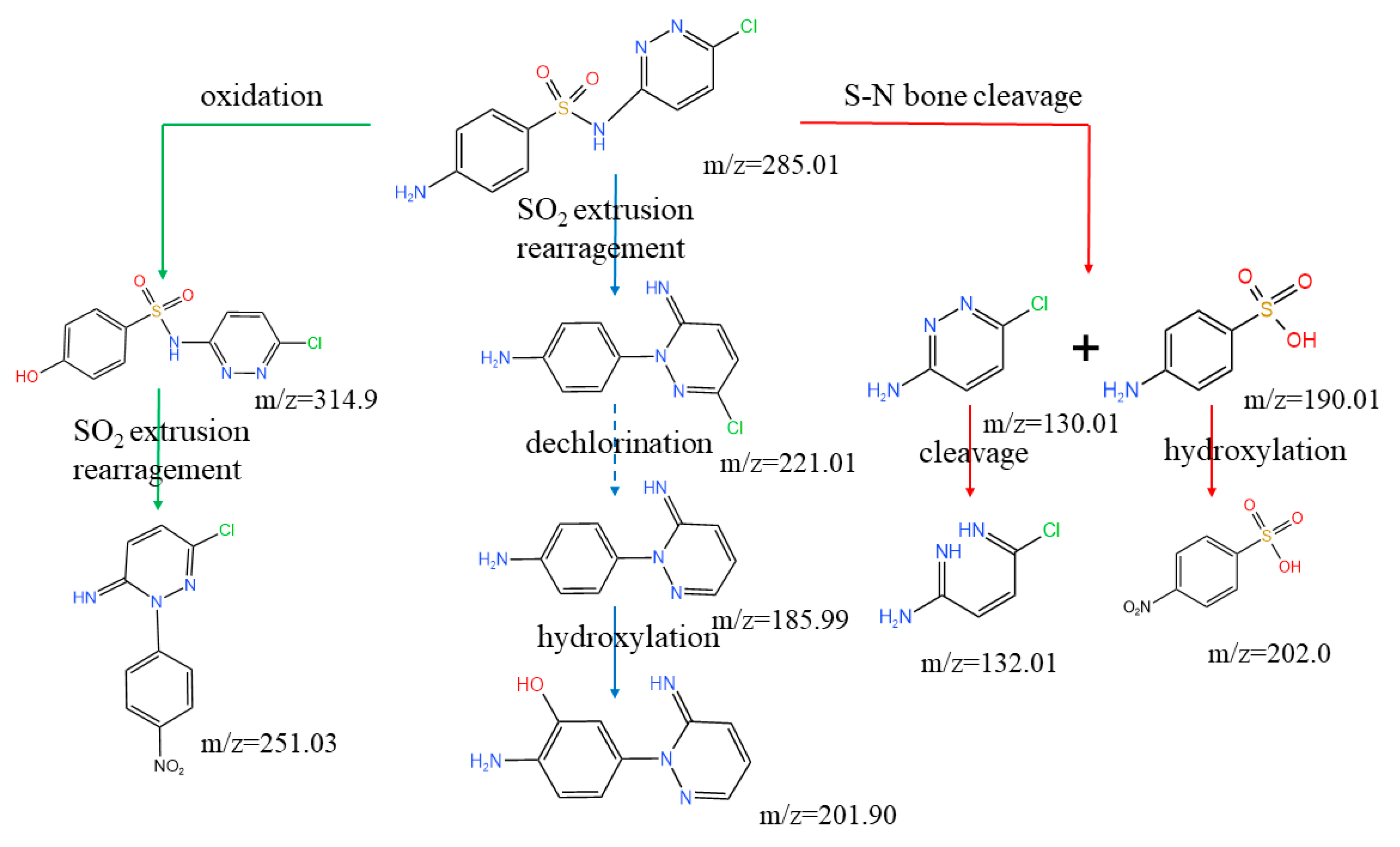
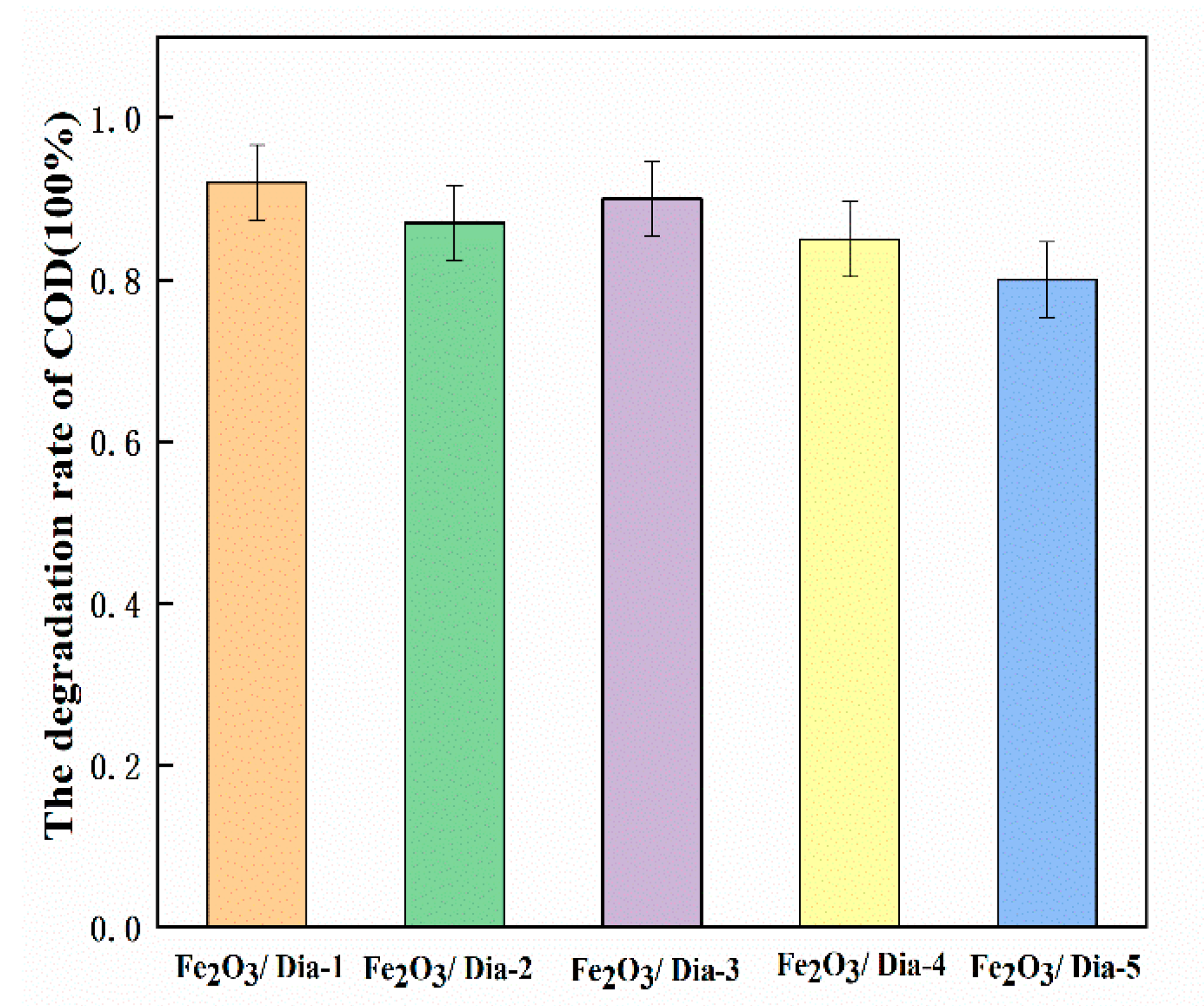
| Samples | Specific Surface Area/ m2·g−1 | Total Pore Capacity/cm3·g−1 | Average Pore Size/nm |
|---|---|---|---|
| Fe2O3 | 19.70 | 0.1540 | 24.75 |
| Fe2O3/Dia | 22.36 | 0.1909 | 30.28 |
Disclaimer/Publisher’s Note: The statements, opinions and data contained in all publications are solely those of the individual author(s) and contributor(s) and not of MDPI and/or the editor(s). MDPI and/or the editor(s) disclaim responsibility for any injury to people or property resulting from any ideas, methods, instructions or products referred to in the content. |
© 2024 by the authors. Licensee MDPI, Basel, Switzerland. This article is an open access article distributed under the terms and conditions of the Creative Commons Attribution (CC BY) license (https://creativecommons.org/licenses/by/4.0/).
Share and Cite
Yu, Y.; Wang, L.; Wu, Z.; Liu, X.; Liu, Z.; Zhang, L.; Li, L. Catalytic Ozonation of Sulfachloropyridazine Sodium by Diatomite-Modified Fe2O3: Mechanism and Pathway. Catalysts 2024, 14, 540. https://doi.org/10.3390/catal14080540
Yu Y, Wang L, Wu Z, Liu X, Liu Z, Zhang L, Li L. Catalytic Ozonation of Sulfachloropyridazine Sodium by Diatomite-Modified Fe2O3: Mechanism and Pathway. Catalysts. 2024; 14(8):540. https://doi.org/10.3390/catal14080540
Chicago/Turabian StyleYu, Yang, Lingling Wang, Zhandong Wu, Xuguo Liu, Zhen Liu, Lijian Zhang, and Lixin Li. 2024. "Catalytic Ozonation of Sulfachloropyridazine Sodium by Diatomite-Modified Fe2O3: Mechanism and Pathway" Catalysts 14, no. 8: 540. https://doi.org/10.3390/catal14080540
APA StyleYu, Y., Wang, L., Wu, Z., Liu, X., Liu, Z., Zhang, L., & Li, L. (2024). Catalytic Ozonation of Sulfachloropyridazine Sodium by Diatomite-Modified Fe2O3: Mechanism and Pathway. Catalysts, 14(8), 540. https://doi.org/10.3390/catal14080540







